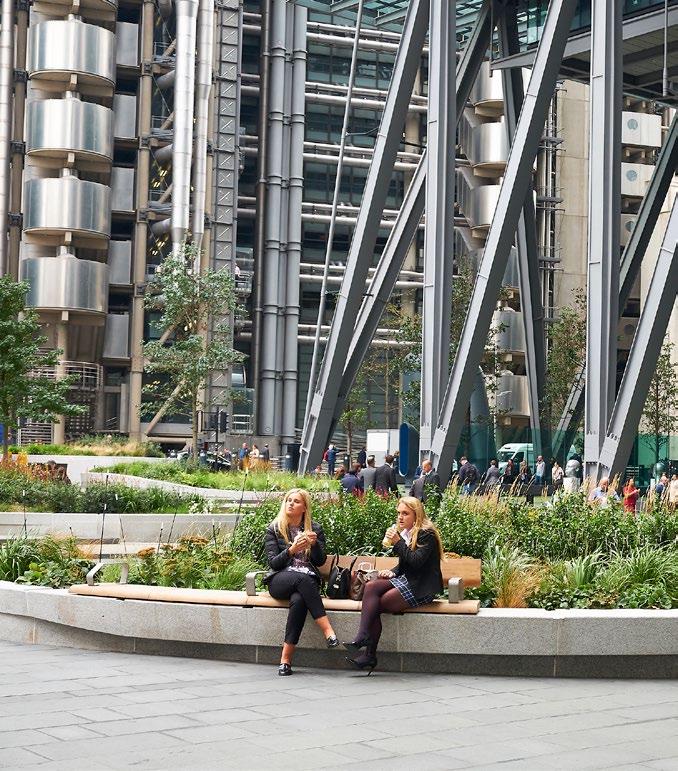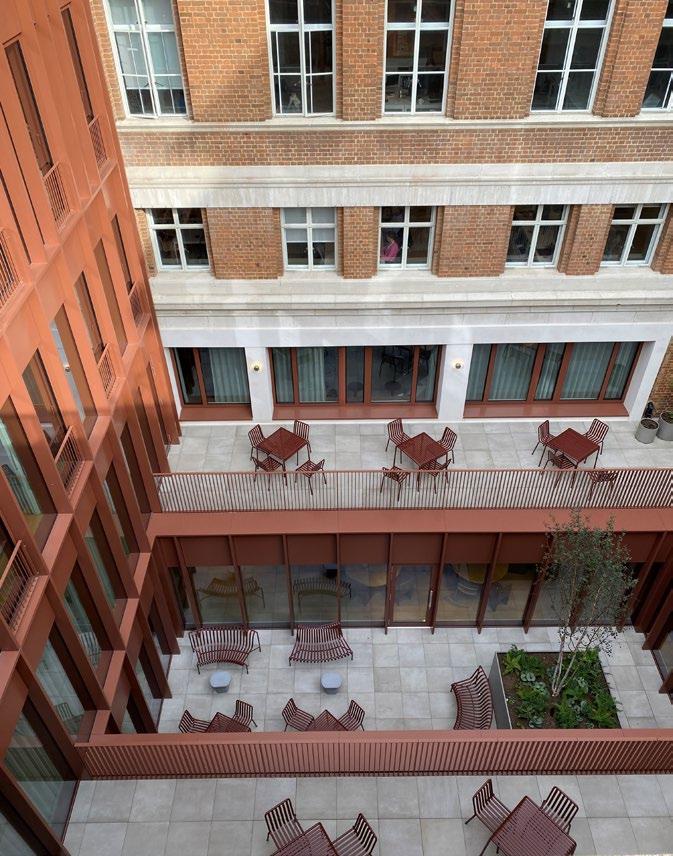

Offices 5
Strategic Policy S4: Offices
The City Corporation will facilitate significant growth in office development of the highest quality to meet projected economic and employment growth by:
1. Increasing the City’s office floorspace stock by a minimum of 1,200,000 m2 net during the period 2021 to 2040, phased as follows:
X 2021 – 2026 500,000m2
X 2026 – 2031 400,000m2
X 2031 – 2036 200,000m2
X 2036 – 2040 100,000m2
2. Ensuring that new floorspace is designed to be flexible to allow the transformation and adaptation of space to support new uses, different layouts and configurations, different types and sizes of occupiers, and to meet the needs of Small and Medium Enterprises (SMEs), start-up companies, creative industries and those requiring move-on accommodation.
3. Promoting the retrofitting of existing office buildings for office use and upgrades to their environmental performance and the quality of accommodation.
4. Where appropriate, encouraging the provision of affordable office workspace that allows small and growing businesses the opportunity to take up space within the City.
5. Protecting existing office stock from being lost to other uses where there is an identified need or where the loss would cause harm to the primary business function of the City. Where necessary, conditions may be attached to permissions for new office floorspace to secure its long-term use for such purposes.

Reason for the policy
5.1.0 The City of London is a world leading international financial and professional services centre and has a nationally important role in the economy. The intense concentration of business occupiers in a small area is a key part of the attraction for companies looking to move into the City. The clustering of businesses is a vital part of the City’s operation and contributes to its reputation as a dynamic place to do business as well as providing agglomeration benefits. The City lies wholly within London’s Central Activity Zone (CAZ) where the London Plan promotes further economic and employment growth.
5.1.1 To maintain this position, it is vital to ensure that sufficient office floorspace is available to meet projected employment growth and occupier demand and that additional office development is of high quality and suitable for a variety of occupiers. The overall office floorspace target of 1,200,000m2 is derived from the estimated growth in office employment between 2021 and 2040 and represents a 13% increase in floorspace. Capacity modelling demonstrates that there are sufficient sites to meet this demand, provided primarily within the City Cluster area, supplemented by additional capacity elsewhere in the City.
5.1.2 The demand target is the central of three projections, based on different scenarios for office attendance, office densities, occupancy rates and employment projections. The central target is aligned with GLA 2022-based long term employment projections for London and the Square Mile.
5.1.3 Recent years have also seen strong demand for ‘best in class’ or Grade A+ floorspace. Many businesses are placing greater value on high quality sustainable and well-being credentials, quiet spaces for phone calls or working, abundance of meeting spaces and places for collaboration, good access to public transport and food and beverage amenities as well as design that communicates the company’s brand and values.
5.1.4 Office floorspace need will be met through the delivery of new office space and through the refurbishment and retrofit of existing space to comply with current office floorspace standards and meet the Government-set requirements for minimum energy efficiency standards.
5.1.5 Traditional office based jobs are the dominant sector in the Square Mile, representing 59% (346,000) of all jobs in 2021, but emerging office-based firms are faster-growing, consisting of 41,600 new jobs (+62% between 2015 and 2021). There were 22,300 businesses and 590,000 workers in the City in 2021 and employment is projected to continue to grow over the long term. The City accommodates 440,000 office based jobs in an estimated 5.3 million m2 (Net Internal Area) of office space. Over 99% of all the City businesses are SMEs with fewer than 250 employees; 80% have fewer than 10 employees.
Offices 5
5.1.6 In 2023, 29% of take-up of office floorspace in the City of London was from media and tech firms, compared to 19% from financial companies, indicating an increasing shift away from the dominance of financial services, and an increasing demand from new types of occupiers. This broader range of occupiers is creating requirements for a broader range of office types.
5.1.7 Demand for Incubator, Accelerator and Co-Working (IAC) floorspace is predicted to continue to grow across London and this type of accommodation is seen as important to the growth of SMEs. Delivering these types of workspace within the City will meet the needs of smaller businesses in particular and help to grow both the City and the wider London economy.
5.1.8 As well as providing flexible space, it is important to ensure that there is floorspace that is affordable to start-up and growing businesses. Accommodation costs are a major overhead for new businesses and rents in the City can be prohibitive to new occupiers. The City has seen substantial growth in the serviced and co-working office market in recent years and flexibility of lease arrangements provides a range of opportunities to accommodate both new and growing businesses. Developers and building owners are also encouraged to consider a range of leasing structures, including below market rents to ensure that a range of affordable workspaces are available to meet demand, in particular from new and emerging sectors of the economy and creative industries.

Offices 5
How the policy works
5.1.9 Strategic Policy S4 indicates the amount of floorspace required to meet the forecast employment growth and will encourage the flexible floorspace needed to attract and retain a range of occupiers.
5.1.10 The delivery of floorspace in the City will be phased across the plan period, with indicative phasing targets identified in the policy. Phasing allows for short term monitoring of progress in meeting floorspace targets and effective planning for supporting services and infrastructure. A significant amount of office floorspace is under construction in the City, much of which will be completed in the first two phasing periods.
5.1.11 The City Corporation has made an Article 4 Direction removing permitted development rights for the change of use of offices (E(g)(i)) to dwelling houses (C3) across the whole of the City. The Direction is consistent with the approach to office development and protection of offices set out in this Plan.
5.1.12 Changes to the Use Classes Order introduced in September 2020 mean that offices can be converted to a range of other Class E commercial, business and service uses without planning permission. Where permission is granted for office schemes that meet a specific identified need, conditions may be attached to ensure the impacts of any proposed later conversion of such space can be considered through the planning application process.

Offices 5
Policy OF1: Office Development
1. Office development should:
a. Prioritise the retrofitting of existing buildings;
b. Be of an outstanding design and an exemplar of sustainability;
c. Be designed for future flexibility to future proof the City’s office stock and realise the principles of circular economy design approaches;
d. Provide office floorspace suitable for a range of occupiers;
e. Provide healthy and inclusive working environments that promote wellbeing; and
f. Where appropriate, provide a proportion of flexible and affordable workspace suitable for micro, SMEs.
2. Other commercial uses will be encouraged as part of officeled development, particularly at ground and basement levels, where such uses would not compromise the operation of office premises, would activate streets and provide supporting services for businesses, workers and residents.

Reason for the policy
5.2.0 A range of office floorspace is required to accommodate the future needs of the City’s office occupiers and this should include provision for incubator, co-working and accelerator space, as well as provision for larger firms where required. Flexible and affordable office floorspace is required that can be easily adapted to meet changing workplace and technology requirements and the needs of a variety of office occupiers.
5.2.1 Offices are the predominant land use in the City, but complementary uses are required to provide supporting activities and services for businesses, workers and residents in appropriate locations within the City. Complementary uses which contribute to the City’s economy include retail, leisure, education, health facilities and cultural uses. A mix of commercial land uses, in particular at ground floor and basement levels, will be required to create active frontages enhancing an area’s vitality and provide important complementary services. They also provide opportunities for creativity, collaboration and social interaction, which are key to the success of the City’s business clusters. Some uses have the potential to undermine the functioning, servicing and use of offices, particularly in areas of high density employment and where offices are required to be serviced overnight.
How the policy works
5.2.2 Proposals for new office development should demonstrate design quality and flexibility to accommodate a range of businesses. Particular encouragement will be given to floorspace which meets the needs of small businesses, start-ups and incubator space. Office development should include a suitable mix of complementary commercial or other uses appropriate to the site and location and contribute to the creation of active frontages at street level. Where appropriate, conditions or legal obligations may be used to ensure the delivery of a range of affordable workspaces.
5.2.3 Many office lobbies have been designed to project a corporate image, and function as through space to access lifts. This can lead to a blank frontage on the street, especially with large windows on the facade with minimal internal activity and no public access. A lobby has the potential to be a more interesting and engaging space. Lobbies can be multifunctional spaces for interaction and provide spaces that contribute positively to the life of the City. The addition of publicly accessible facilities (including public toilets), co working spaces, breakout spaces, art gallery or cafes can create a more active lobby. Office buildings should include dynamic ground level uses to enhance their lobbies. Entrances should be easy to identify and should allow everyone to use them independently without additional effort, separation or special treatment. Revolving entrance doors are not accessible to a range of people.
Offices 5
Policy OF2: Protection of Existing Office Floorspace
1. The loss of existing office floorspace will be resisted unless it can be demonstrated that:
a. The proposed development would not lead to the loss of office floorspace that is, or sites that are, of a strategically important scale, type and/or location for the City;
b. The proposed development would not compromise the potential for office development on sites within the vicinity; and
c. There is no demand in the office market, supported by marketing evidence covering a period of no less than 12 months.
2. Where the criteria in part 1 of this policy have been met, proposals that would lead to the loss of existing office floorspace may follow one of the following routes:
a. Viability tested route: Proposed development will be required to demonstrate that the retention, refurbishment or reprovision of the office floorspace would not be viable in the longer term, demonstrated by a viability assessment;
b. Retrofit fast track: Proposed development will be required to retain the substantial majority of the superstructure of the existing building, lead to an improvement in the environmental performance of the building, and result in change of use to (one or a mix of) hotel use, cultural uses, and/or educational use. Partial retention of office floorspace will be encouraged;
c. Residential areas route: the loss of office floorspace is proposed on a site within or immediately adjacent to identified residential areas and would result in the provision of additional housing;
d. Ground floor uses: the loss of office floorspace would be limited to ground or below ground levels, and proposed new uses would be complementary to continued office use on upper floors. Active frontage uses will be required at ground floor levels in most instances.
Offices 5
Reason for the policy
5.3.0 The City is the world’s leading international financial and professional services centre and is recognised as having a key role in the UK economy. To maintain this position and accommodate the projected increase in employment and office floorspace, it is important to retain the substantial majority of existing office stock whilst accommodating future demand through the provision of flexible floorspace that is suitable for a range of occupiers and refurbished office space.
5.3.1 The protection and refurbishment of existing office space is important to ensure that there is sufficient floorspace to meet future demand, and to offer a range of office stock to provide choice in terms of location and cost to potential occupiers. This includes ‘best in class’, grade A and grade B floorspace. While the current market for grade B space in the City is facing headwinds, with some traditional grade B occupiers shifting to more flexible working patterns or seeking other forms of flexible workspace, it remains uncertain whether this will persist over the longer term. This will be monitored and guidance will be issued if required to provide additional advice on appropriate responses to this potential challenge.
5.3.2 Following changes to the Use Classes Order introduced in September 2020, existing offices can be converted to a range of other Class E commercial, business and service uses without planning permission, unless there are specific planning conditions attached to a site which prevent this.

Offices 5
5.3.3 Refurbishment of office floorspace will be encouraged to accommodate future needs, whilst aligning with the sustainability principles set out in Policy DE1 and the need to find suitable and sustainable uses for historic buildings.
5.3.4 The City of London Local Plan has for many years sought to protect suitably located and viable office floorspace, with marketing and viability evidence required to support proposals that result in a loss of office floorspace. This approach, supported by policy in the London Plan, has successfully protected the critical mass of office floorspace in the City, helping to maintain its primary office function. This broad approach will be maintained. However, there are instances where conversion of office buildings to other uses may assist in making the retention of existing buildings a more attractive investment opportunity, contributing to the ‘retrofit first’ approach promoted in this Plan. This approach could also assist in delivering a greater range of facilities and uses in the City, complementing the primary function of the Square Mile while helping to deliver more vibrancy and a focus on increasing visitors. To achieve this, the ‘retrofit fast track’ approach has been introduced, removing the requirement for viability justification for a change of use in the circumstances set out in policy. The alternative uses set out – education, culture and hotels – would all help to create a more vibrant Square Mile.
5.3.5 Within and immediately adjacent to identified residential areas, the loss of office floorspace for which there is no ongoing demand may assist in providing housing, to help meet the housing requirement set out in this Plan.

How the policy works
5.3.6 Where loss of office is proposed, development will need to meet all the criteria set out in part 1 of the policy, and will need to pursue one of the four routes set out in part 2.
5.3.7 Robust evidence of the marketing of the building or site for continued office use over a period of at least 12 months will need to be demonstrated to comply with part 1 of the policy. The City Corporation will need to be satisfied that the site/building has been offered at a realistic price commensurate with the value of the site/building for office use and that active promotion has been undertaken by the agents marketing the site over the period.
5.3.8 Viability assessments submitted in accordance with this policy will be made public, other than in exceptional circumstances, as set out in Policy PC1. Viability assessments should include the following:
X Site description;
X A valuation of the building in its existing use unfettered by any hope value;
X Total costs of maintaining the building as existing and in the future;
X Costs of refurbishing or redeveloping the building for office use;
X Information on rents and capital values;
X Information on current and recent occupation;
X Target rates of return (internal rate of return or other appropriate measure); and
X Sensitivity testing to support the robustness of the report conclusions.
5.3.9 Where a change in use is proposed from office floorspace to another use, including complementary uses which enhance the attractiveness of the City, or meet other policy priorities set out in this Plan, then the provision of a full viability assessment may not be required. This would include where complementary uses meet the needs of City workers, residents and visitors and help make City buildings much more open and welcoming to all, or where educational facilities which help attract talented individuals or innovative business to the City are proposed. It would also include where the change of use of office floorspace at ground and lower ground levels improves the vibrancy of an area by introducing more active frontages and delivering more permeable buildings and spaces. The priority to reduce carbon emissions and retain embodied carbon set out in Plan also means that changes of use from office to alternative uses which retain embodied carbon may also not require full viability information to justify the loss of office.
5.3.10 Further guidance on the evidence required to support the loss of office floorspace is set out in the Office Use SPD.
Policy OF3: Temporary ‘Meanwhile’ Uses
1. Temporary use of vacant commercial, business and service buildings or sites (‘meanwhile’ uses) will be encouraged where the proposed use would not result in adverse impacts on the amenity of the surrounding area or the primary business role of the City. Where temporary permission is granted, it will be for a period not exceeding 36 months and the site will revert to its prior lawful use thereafter. Culture and Vibrancy Plans (CVPs) that accompany major developments should explore the potential for meanwhile use.
2. Residential development is not considered an appropriate meanwhile use and will not be permitted.
3. Where a major development would affect existing ground floor or podium level active uses (Class E (a)-(f)), these units should be kept in active use for as long as possible prior to development taking place. CVPs should set out how this will be achieved.
Reason for the policy
5.4.0 Where buildings or sites in Class E commercial, business or service uses are vacant, and development is not expected in the short term, ‘meanwhile’ or temporary uses will be supported to ensure the vitality and vibrancy of the City is maintained, subject to the impact on surrounding uses.
5.4.1 Many development sites in the City include shops, restaurants and other active uses within the curtilage. Where leases end prior to redevelopment, these units can remain vacant for long periods, undermining the vibrancy of the area. Meanwhile uses of these spaces prior to redevelopment would help to address this.
How the policy works
5.4.2 ‘Meanwhile’ uses will be granted subject to conditions for a maximum of 36 months, after which the use will revert to its prior lawful use. Applications to extend the period of the ‘meanwhile’ use or make it permanent will be considered against the relevant policies in the Development Plan and will not be permitted unless it is demonstrated that the permanent loss of the prior lawful use is acceptable.
